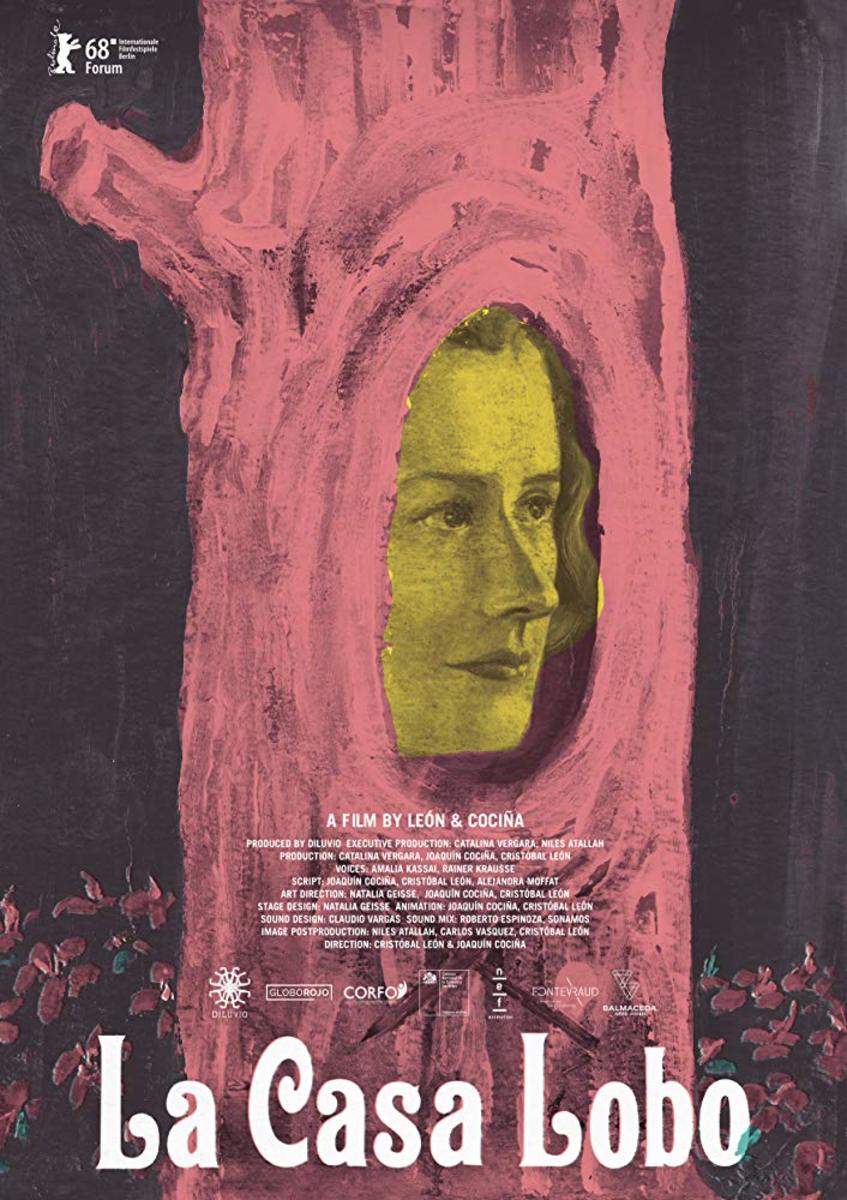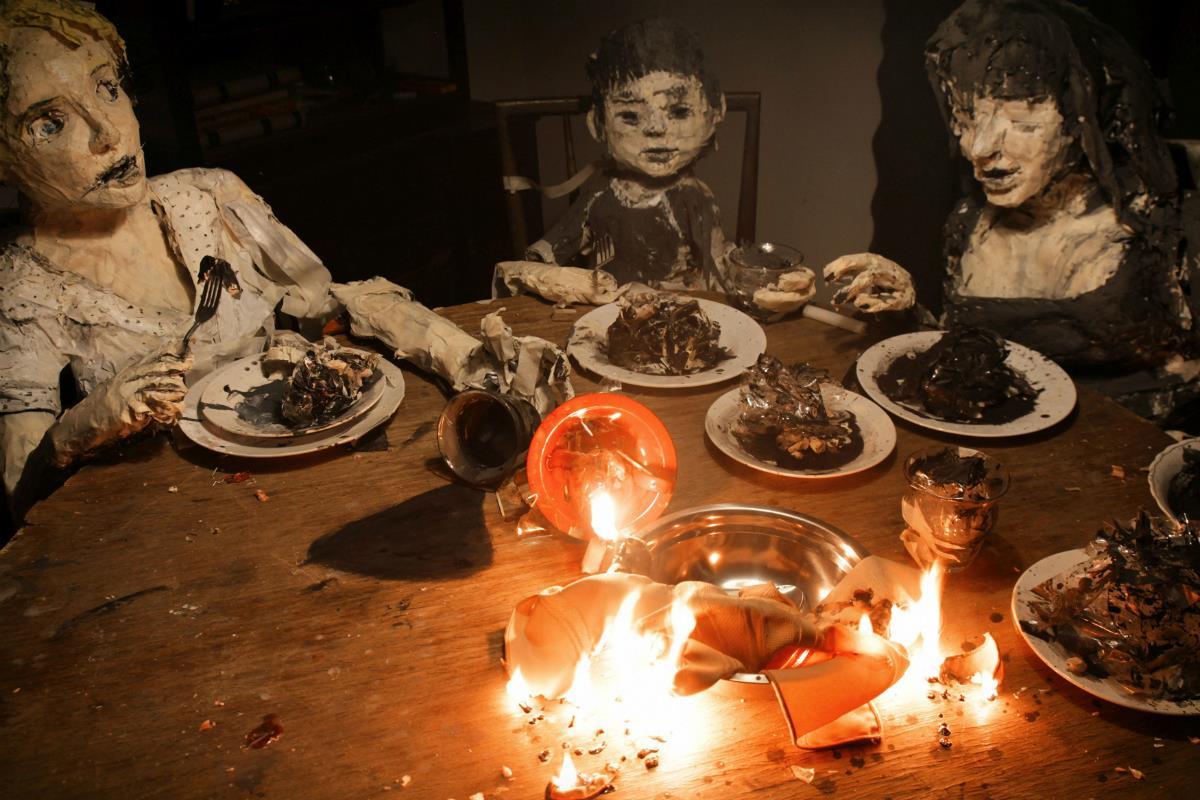 |
| From https://usercontent1.hubstatic.com/ 14226322_f520.jpg |
Directors: Joaquín Cociña and Cristóbal León
Screenplay: Alejandra Moffat, Joaquín
Cociña and Cristóbal León
Cast: Amalia Kassai as María;
Rainer Krause as the Wolf
Synopsis: Presented as a propaganda film of "the Colony",
this stop motion story presents a fairy tale of a girl who flees the commune
only for her to learn of the error of her ways when, is closing herself in an
abandoned house and helping two pigs become human, they start to turn on her.
[Major Spoiler Warnings]
[Trigger Warnings]
 The Wolf House, the co-creation of Joaquín Cociña and Cristóbal
León with script collaboration by Alejandra Moffat, does have a historical
context which might be missed if only established in the presentation. Many
Nazis, after World War II, fled to South America, the discomforting parallels
in symbolism found through the film's world. The Wolf House also evokes another historical context that is Colonia
Dignidad, an infamous real life commune in Chile that, under the figure of
German exile Paul Schäfer, was not
only tied to the rise of the Pinochet
dictatorship within the country and Nazi war criminals but was a place of abuse,
child molestation and various horrifying actions that Schäfer was only
arrested for 2005 after fleeing authorities in 1997.
The Wolf House, the co-creation of Joaquín Cociña and Cristóbal
León with script collaboration by Alejandra Moffat, does have a historical
context which might be missed if only established in the presentation. Many
Nazis, after World War II, fled to South America, the discomforting parallels
in symbolism found through the film's world. The Wolf House also evokes another historical context that is Colonia
Dignidad, an infamous real life commune in Chile that, under the figure of
German exile Paul Schäfer, was not
only tied to the rise of the Pinochet
dictatorship within the country and Nazi war criminals but was a place of abuse,
child molestation and various horrifying actions that Schäfer was only
arrested for 2005 after fleeing authorities in 1997. |
| From https://d2u3kfwd92fzu7.cloudfront.net/ catalog/artwork/gallery/2859/casalobo10.jpg |
Even without this full context, The Wolf House's prologue immediately puts you on edge, the directors' willingly playing along as fictional collaborators on a restoration of one of the "Colony's" propaganda films as the voice over (the film juggling German and Spanish) is entirely bias to the commune and against any slander to its reputation, a disarmingly creepy children's chorus in the score like the ghosts of the dead.
Even without the real, horrifying
history context the exploration of this dark and potentially unknown history to
the outside world from Chile means the creators already set up, using archive
footage of idyllic country life with blond haired children and honey as the
images, the perfect tone to set up a dank underbelly that presides over all the
images without become overbearing. And The
Wolf House, part of a tradition of stop motion animation, can proudly stand
out among the likes of Jan Svankmajer
and the Quay Brothers as a truly
radical, painstakingly executed animation with hard earned artistry, in which Cociña and León to best describe the style starts in bookends with chalk drawn
animation when the protagonist Maria (voiced by Amalia Kassai) flees the Colony and enters the titular house, only for
the place to be a living and breathing animation itself. As a wolf stalks
outside (speaking in German) becomes the sinister menace of the Colony in his
sense of superiority and an underlying sexual nature to his comments of his
beloved "little bird", the animation inside the home takes place in
one giant set which is constantly built and deconstructed, the tape used to
keep paper-mâché figures up and in poses sometimes visible, all whilst the film
openly records as much the work to construct and tear down each sequence as
part of scene transitions as it is the story. Some of the animation as well is
painted on the walls and floors, to be erased after in such a way. The jerky
motion of all is something that adds to the sense of ill-ease alongside the uncanny
nature of the entire artificiality living world.
 |
| From https://d1nslcd7m2225b.cloudfront.net/Pictures/2000x2000fit/ 9%2F8%2F2%2F1279982_thewolfhouse_199817.jpg |
It is the equivalent of taken an abandoned building, and using the content of its garage and second hand furniture to make a film, a lot of paper-mâché and paint used for the production. I view all cinema, with this in mind, as hard work worth praising, even if it can be utterly wasted on bad films, but animation or work that visibly looked like hard work is to be more admired for its laborious, difficult craft especially as it has an innate tactility that is inherently (yet ignored) in the medium of cinema especially now in the digital camera age. It fits the material in terms of story here too as Maria finds two pigs and encourages them to transform into human beings, the characters both existing as figures but also painted only the walls and floors, sometimes using props like picture frames to depict them in extreme close-up. It's inherently skittish and fragmented as a film scene per scene, the animation as mentioned already creepy before you see it move in this fragmented movement.
Following Svankmajer's skill of animating life in an everyday objects, whilst
The Wolf House doesn't follow the
Czech animator's transgressive details like animating actual meat does have the
same nightmarish quality to the material which plays into the story they are
used for. The film reaches a moment of idealism for Maria and her pig children,
briefly reaching a respite, but even before the Wolf's mocking affection is
unnerving and one witnesses sights like pigs with human hands for feet or a papier-mâché
boy on a toilet being terrorised and covered in bugs. After, as food is
becoming scare and the pig children decide to eat Maria, the film without any
direct transgression, aside when the children are accidentally burned by a
candle falling on the table cloth and having to recover from their injuries, is
riddled in a darkened fairytale mood.
 |
| From https://fantasticfest-site.s3.amazonaws.com/films/42331/ wolf_house_15_4web__large.jpg |
The back story of what The Wolf House is eluding, if known, makes it more unsettling. The children, beginning as pigs, become children with dark features only for honey, the produce famous from the Colony, turns them into angelic children with blonde hair and blue eyes. The wolf, symbolically evokes Nationalist use of pagan symbols, and its entire bias to the wolf saving Maria in the end after she regrets rebelling against the Colony whilst in lieu to the film being a fake propaganda work is even more disturbing when her monologues clearly evoke hints of abuse, even sexually, and being forced into a collective beforehand. The animation's beauty doesn't stop its coarse and textual style from adding to all of this subtext and, with this in mind, I will be cautious in terms of recommending the film due to how disturbing it is to see. Nonetheless, it's an incredible piece of art that, if you are prepared for that challenging nature, is worthy to witness.
Abstract Spectrum: Handmade/Insidious/Lo-Fi/Nightmarish
Abstract Rating (High/Medium/Low/None): High
Personal Opinion
As a film premiering in 2018, The Wolf House deserves to be seen as
an incredible cinematic achievement, more worthy of attention than more
publicised films. Whether, baring temporary screening on MUBI, a film this important can avoid being lost in the film
festival circuit may be as much entirely helped by a tiny little blog like this
bring attention to this fascinating, artistically rewarding animation as much
as a proper film critic. In terms of animation as a medium, Joaquín Cociña and Cristóbal León have already shown a unique style in-between them
that deserves to be explored further in short and long form filmmaking.
| From http://etiudaandanima.pl/wp-content/uploads/2018/11/Dom-wilka.jpg |
No comments:
Post a Comment